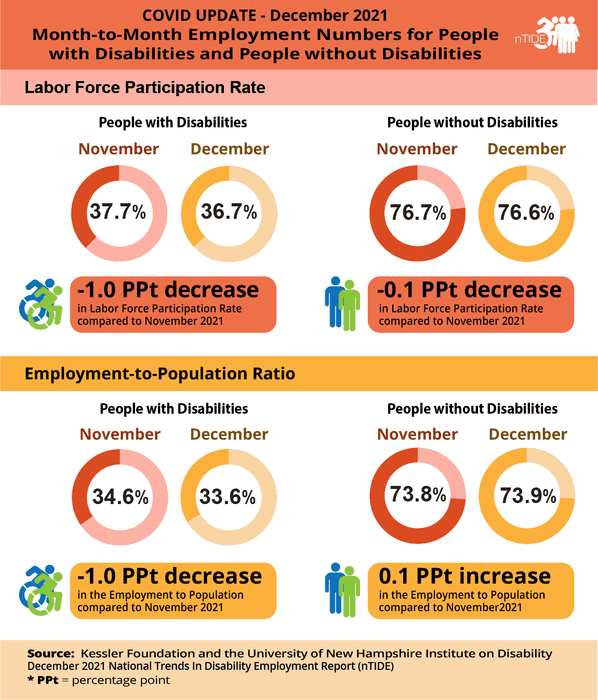Despite a small decline in December, the job numbers for people with disabilities remained above pre-pandemic levels, according to the recent National Trends in Disability Employment – Monthly Update (nTIDE), issued by Kessler Foundation and the University of New Hampshire’s Institute on Disability (UNH-IOD).
This contrasts with people without disabilities, who have yet to reach pre-pandemic levels of employment. Experts cautioned that the time frame for the December numbers does not yet reflect the potential impact of the rapid rise in the COVID-19 omicron variant.

nTIDE COVID Update
According to the recently released BLS Jobs Report, the employment-to-population ratio for working-age people with disabilities decreased from 34.6% in November to 33.6% in December (down 2.9% or 1 percentage point). For working-age people without disabilities, the employment-to-population ratio increased slightly from 73.8% in November to 73.9% in December (up 0.1% or 0.1 percentage point).
The employment-to-population ratio, a key indicator, reflects the percentage of people who are working relative to the total population (the number of people working divided by the number of people in the total population multiplied by 100).
“While December is down compared to November, this is still the fourth consecutive month that we are seeing the employment-to-population ratio exceed the historic high points for people with disabilities. It appears that the pandemic has created a labor market where people with disabilities, who are often characterized as resourceful, may be capitalizing on supply-side shortages.”
— John O’Neill, PhD, director of the Center for Employment and Disability Research at Kessler Foundation
The labor force participation rate for working-age people with disabilities decreased from 37.7% in November to 36.7% in December 2021 (down 2.7% or 1 percentage point). For working-age people without disabilities, the labor force participation rate also decreased slightly from 76.7% in November to 76.6% in December 2021 (down 0.1% or 0.1 percentage point).
The labor force participation rate is the percentage of the population that is working, not working and on temporary layoff, or not working and actively looking for work.
“While the labor force participation rate of people with disabilities declined for the first time in several months, it remains strong, having exceeded pre-Pandemic levels since June 2021. The labor force participation rate of people without disabilities has yet to reach pre-Pandemic levels. We will be looking in the coming months to see if people with disabilities continue the upward trend we saw over much of 2021.”
— Andrew Houtenville, PhD, professor of economics and the research director of the University of New Hampshire’s Institute on Disability
Year-to-Year nTIDE Numbers
The employment-to-population ratio for working-age people with disabilities increased from 29.4% in December 2020 to 33.6% in December 2021 (up 14.3% or 4.2 percentage points). For working-age people without disabilities, the employment-to-population ratio also increased from 70.9% in December 2020 to 73.9% in December 2021 (up 4.2% or 3 percentage points).
The labor force participation rate for working-age people with disabilities increased from 33.2% in December 2020 to 36.7% in December 2021 (up 10.5% or 3.5 percentage points). For working-age people without disabilities, the labor force participation rate also increased from 75.7% in December 2020 to 76.6% in December 2021 (up 1.2% or 0.9 percentage points).
In December 2021, among workers ages 16-64, the 5,473,000 workers with disabilities represented 3.8% of the total 144,964,000 workers in the U.S.
[Source(s): Kessler Foundation, EurekAlert]





